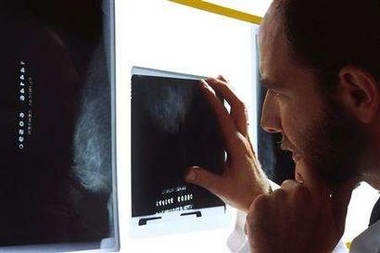Study: MRIs for women at risk for cancer
(AP)Updated: 2007-03-28 13:39
ATLANTA - Up to 1.4 million US women - those with an unusually high risk of developing breast cancer - should get annual MRIs as well as mammograms, the American Cancer Society advises in new guidelines.
The study came out after the cancer society developed its guidelines, which are the first to recommend MRI for screening women who show no signs of cancer.
The guidelines are directed at symptomless women age 30 and older who have a mutation in the BRCA1 or BRCA2 genes; those who were treated for Hodgkin's disease; or those with a strong family history of the disease, such as women with two or more close relatives who had breast or ovarian cancer or who have a close relative who developed breast cancer before age 50.
As many as 1.4 million women fall into the affected group, according to an American Cancer Society estimate.
Doctors usually screen for breast cancer using mammography, an X-ray technique that can spot dense masses like tumors.
MRI, or magnetic resonance imaging, makes more detailed images with a magnet and radio waves - but without radiation. MRIs are better at showing increased or abnormal blood flow in the breast, a sign of early cancers not visible on a mammogram. They also are better than mammograms at detecting cancer in women with dense, non-fatty breasts.
But MRI screening is not being recommended for most women. One reason is the test's error rate, which can lead to unnecessary biopsies.
Another is the high cost. While a mammogram costs roughly $100 to $150, an MRI can cost $2,000 or more at some medical centers, experts said.
"It's very, very expensive," said Robert Smith, the cancer society's director of cancer screening. Many insurers cover MRI screenings, but not all do, Smith and others said.
Insurers generally follow government guidelines, but the cancer society guidelines could prove influential, according to experts.
The new guidelines were being announced Wednesday, the same time the New England Journal of Medicine was releasing a national study that suggests women who have cancer diagnosed in one breast should get an MRI in the other.
The study, led by Dr. Constance Lehman of the University of Washington Medical Center, looked at nearly 1,000 women recently diagnosed with cancer in one breast but who had no detected cancer in the second breast.
MRIs of the second breast found possible tumors in 121 of the women. Biopsies confirmed cancer in 30 of them.
"It's a pretty striking effect," said Dr. Carl Jaffe of the National Cancer Institute, which sponsored the study.
But it does not suggest MRIs should replace mammograms, which spot calcium deposits better than MRIs do, said Dr. Etta Pisano of the University of North Carolina, one of the study's authors.
"The take-home message of our paper is not, 'Don't get mammography.' It's 'Get MRI and mammography,'" she said.
Cancer society officials urged women to carefully choose the clinic that does the MRI. They noted that some facilities that offer MRI lack the expertise and equipment to do an MRI-guided biopsy, meaning the MRI will have to be repeated elsewhere if a possible tumor is found. Breast MRIs should be done at places that do biopsies as well, they said.
This year, the American College of Radiology is expected to start a voluntary accreditation program to help ensure the quality of breast MRI testing, cancer society officials said.
For women at high risk for breast cancer, the test is definitely worthwhile, said Courtney From Hirsch, 26, of Raleigh, N.C. She feels that way despite MRI errors that led to two unnecessary biopsies.
Hirsch's mother was diagnosed with breast cancer in 2004, and Hirsch and her younger sister both tested positive for the BRCA1 mutation. They are among an estimated 22,000 women in the United States who have tested positive in the 10 years since the test became available.
Hirsch said she also has the kind of dense breasts that are problematic for mammograms.
She's had four breast MRIs in the past two years, two of them done as part of biopsies, but fortunately nothing has been found.
There are downsides, she said: Lying in an MRI scanner for an hour or more can be uncomfortable. Her family has paid $10,000 out-of-pocket for uncovered costs from mammograms, MRIs and biopsies in the last two years. It can be difficult to schedule "magnet time" at the busy UNC cancer center where she gets her screenings. False positives can be frightening, and one of the biopsies left scarring that she said was visible at her February wedding.
"I'd rather have as many scars as I need to on my body to prevent getting cancer," she said.
|
||
|
||
|
|

